Abstract
In this paper, a new modified roller coaster surface according to a modified orthogonal frame is investigated in Euclidean 3-space. In this method, a new modified roller coaster surface is modeled. Both the Gaussian curvature and mean curvature of roller coaster surfaces are investigated. Subsequently, we obtain several characterizations in Euclidean 3-space.
MSC:
53A04; 53A05
1. Introduction
In differential geometry, the search for certain classes of surfaces with particular features in three-dimensional Euclidean space, such as ruled and developable surfaces which are 1-parameter smooth families of straight lines, has a significant role in the field of civil engineering and architecture (CAD) [1,2,3,4,5,6]. Moreover, the work path and workspace of robotic and/or mechanic operations are formed by these spatial curves and surfaces during the generation process [7,8,9]. One aim of classical differential geometry is the investigation of several classes of surfaces with specific properties, for example, ruled surfaces and revolution surfaces. Thus, it is reasonable to make use of differential geometry to understand these surfaces and spatial curves.
Circular surfaces are also regarded as anessential topic in different areas, such as ruled surfaces. There are two kinds of circular surfaces in investigations: canonical circular surfaces and non-canonical circular surfaces. A canonical circular surface is characterised by a circle crosscut and in which the normal of the circle plane is usually parallel to that of the crosscut. There are several names for the canonical circular surface, including tube surface [10,11,12], pipe surface [13], and canal surface [14,15,16,17]. Moreover, Stasiak et al. [18] designed DNA molecules. A noncanonical circular surface is defined by a non-circular crosscut and the normal of the circle plane is usually not parallel to that of the crosscut. An arbitrary end-effector point P produces a RR circular surface, where R indicates the revolute joint. Hunt [19] studied the algebric equation of a generally RR circular surface and as specified that the diametrical parts along the generally RR circular surface could take the shape of a banana, boomerang, or circle, depending on the values of construction parameters of the RR mechanism. For a general RR circular surface, the spine curve is a circle; however, the normal of a circle plane is generally not parallel with the normal of a crosscut. Cui et al. [20] studied noncanonical circular surfaces.
Roller coasters may appear to be comparatively simple mechanics structures when compared with modern railroad or cars, butthey are excellent illustrations for the use of spacial curve geometries. The geometric definition of the curve of a roller coaster path, beginning with the description of a moving referential, is the path used in this implementation and is described by the sweep of the normal and binormal vectors [21].
A circular surface is a map
defined by
where β,c1, c2:I→E3 and r:I→E>0 [22]. The curve β a base curve and a double of curves a director frame. The standard circles
are called generating circles. A roller coaster surface is defined as
where is the primitive function of the torsion .
Although channel surfaces are well known, roller coaster surfaces have not been studied extensively. Recently, Tuncer et al. [23,24] studied circular surfaces and roller coaster surfaces through theuse of unit quaternions. Abdel-Baky et al. [25] researched local singularities of a space-like circular surface.
In this paper, a modified roller coaster surface according to modified orthogonal frame isinvestigated in Euclidean 3-space. According tothis method, a novel, modified roller coaster is modeled. Both the Gaussian curvature and mean curvature of roller coaster surfaces are investigated. As a result, we obtain severalcharacterizations in the Euclidean 3-space.
2. Preliminaries
Let be an arbitrary curve of arc-length parameter . Let be the moving Frenet frame throughout β. As such, the Frenet derivative formulas are given by
where the functions and are thecurvature and torsion of , respectively,
Let be coordinates in . Let be an analytic curve, where s runs through some interval and be an analytic in . We assume that is non-singular, i.e.,
is notzero. Therefore, we can parametrize by its arc length . Accordingly, we only consider in the following form:
where is analytic in . We assume that the curvature function has discrete zero points or isnot identically zero. As such, we have an orthogonal frame described by
The relations between those and the classical Frenet frame at non-zero points of are
Thus, when and squares of the length of and vary analytically in s. By the definition of or Equation (5), a simple calculation shows that
where
The Equation (6) corresponds to the Frenet-Serret equation in the classical case. Moreover, satisfies:
where denotes the inner product of . We note that the essential quantities in Equations (6) and (7) are and which are analytic in [26,27,28].
The unit normal vector field be on a surface defined by
where Also, the first and second fundamental forms of the surface are defined by
where
Additionally, the invariant functions of the Gaussian curvature and the mean curvature of the surface are described by
respectively.
Definition 2.1.
[29] Let first fundamental formof a surface evolution satisfies following,
Accordingly, the surface evolution and its flow are inextensible.
3. New Modified Roller Coaster Surface in Space
In this section, we introduce the first new modified roller coaster surface by rotating the orthogonal modified frame. We also express this new surface and its properties. In addition, we obtain new roller coaster surfaces by translating the orthogonal modified frame. As a result, these new roller coaster surfaces are called new modified roller coaster surfaces.
To separate a roller coaster surface according to the modified orthogonal frame from that of the Frenet- Serret frame, in the rest of the paperwe shall use notation as a modified roller coaster surface.
In terms of the modified orthogonal frame the parametric expression of the modified roller coaster surfaces can be given by Equation (5)
Proposition 3.1.
In terms of the modified orthogonal frame, the parametric expression of the modified roller coaster surfaces can be given as follows:
where
and
Proof.
We have the natural frame of the surface given by
The quantities are calculated to be
The standard unit normal vector field given by
where
and
Components of second fundamental form are
On the other hand,
So, the proof is complete. □
Corollary 3.2.
Assume the spine curve of a modified roller coaster surface is a unit speed curvewith nonzero curvature. Then, the mean curvature of modified roller coaster surface is given by
Corollary 3.3.
Assume the spine curve of a modified roller coaster surface is a unit speed curvewith nonzero curvature. Ifis inextensible, then
Corollary 3.4.
Let a modified roller coaster surfaceandbe a parallel surface ofin Euclidean 3-space. Then, the equation ofis givenby
whereis a constant.
4. Application
First, let us regarda unit speed circular helix by
where . By using this curve, we obtain a new modified roller coaster surface and its parallel surface:
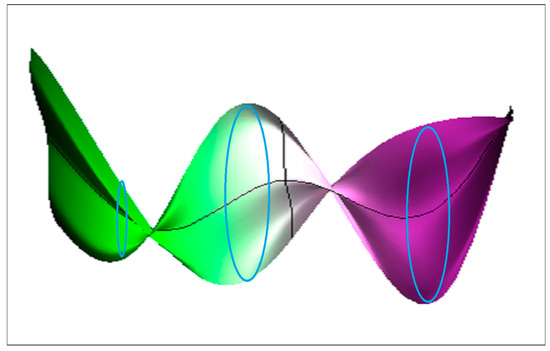
Figure 1.
Modified roller coaster surface.
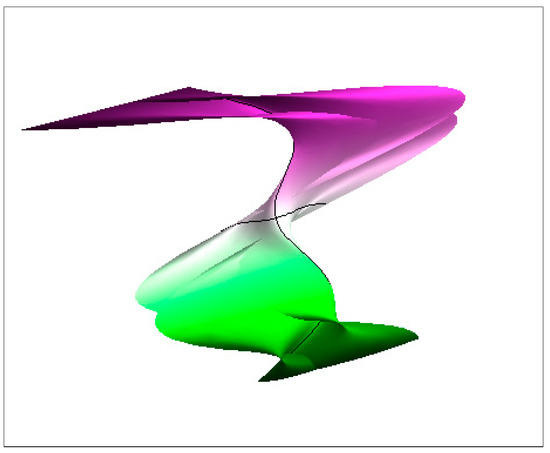
Figure 2.
Its parallel surface.
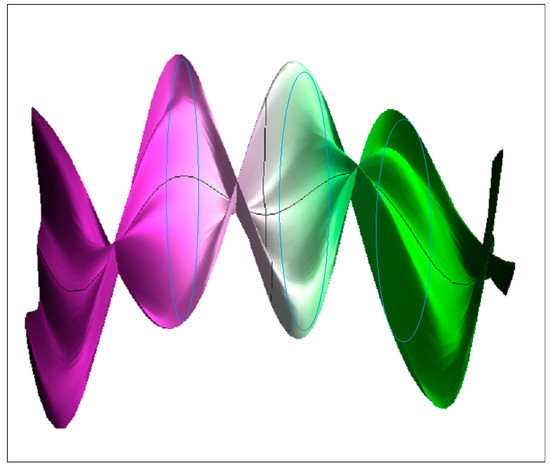
Figure 3.
Modified roller coaster surface.
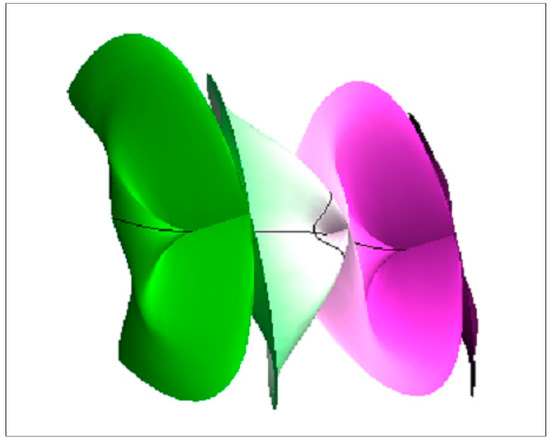
Figure 4.
Its parallel surface.
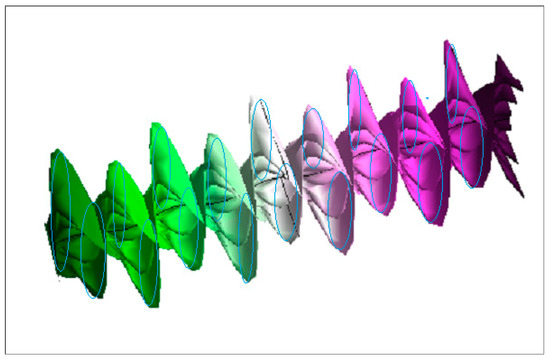
Figure 5.
Modified roller coaster surface.
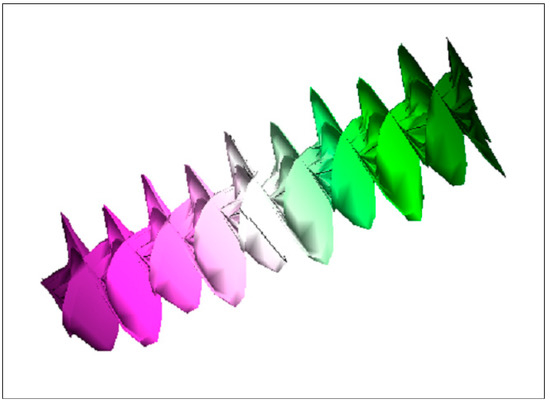
Figure 6.
Its parallel surface.
5. Conclusions
In the literature, we examined the surface of a roller coaster, which has been been studied extensively. The surface of a roller coaster is a similar surface to the tangent surface that can be developed.
In this paper, new roller coaster surfaces according to the modified orthogonal frame are introduced in Euclidean 3-space. Results are provided in relationshipto these new modified roller coaster surfaces. In addition, these concepts are applied to exampleswith figures.
As a result, we obtain new roller coaster surfaces by translating the orthogonal modified frame. Accordingly, these new roller coaster surfaces are called new modified roller coaster surfaces.
According to this method, a new roller coaster is modeled. In light of these results, we will study this concept in the Minkowski space.
Author Contributions
Conceptualization, S.B. and T.K.; Methodology, S.B. and T.K.; Software, S.B. and T.K.; Validation, S.B. and T.K.; Formal Analysis, S.B. and T.K.; Investigation, S.B. and T.K.; Resources, S.B. and T.K.; Data Curation, S.B. and T.K.; Writing-Original Draft Preparation, S.B. and T.K.; Writing-Review & Editing, S.B. and T.K.; Visualization, S.B. and T.K.; Supervision, S.B. and T.K.; Project Administration, S.B. and T.K.; Funding Acquisition, S.B. and T.K.
Funding
This research received no external funding.
Conflicts of Interest
The authors declare no conflict of interest.
References
- Zhang, X.; Zhang, J.; Pang, B.; Zhao, W. An accurate prediction method of cutting forces in 5-axis flank milling of sculptured surface. Int. J. Mach. Tool. Manuf. 2016, 104, 26–36. [Google Scholar] [CrossRef]
- Ryuh, B.S.; Pennock, G.R. Accurate Motion of a Robot End-Effector Using the Curvature Theory of Ruled Surfaces. J. Mech. Transm. Autom. Des. 1988, 110, 383–388. [Google Scholar] [CrossRef]
- Li, C.Y.; Wang, R.H.; Zhu, C.G. An approach for designing a developable surface through a given line of curvature. Comput. Aided Des. 2013, 45, 621–627. [Google Scholar] [CrossRef]
- Pottmann, H.; Wallner, J. Computational Line Geometry; Springer: Berlin, Germany, 2000. [Google Scholar]
- Sprott, K.; Ravani, B. Cylindrical milling of ruled surfaces. Int. J. Adv. Manuf. Technol. 2008, 38, 649–656. [Google Scholar] [CrossRef]
- Izumiya, S.; Takeuchi, N. Special curves and ruled surfaces. Contrib. Algebra Geom. 2003, 44, 203–212. [Google Scholar]
- Baş, S.; Asil, V.; Körpınar, T. A New Version of Five-Axis Motion of Spheres with Spacelike Curves in Minkowski Space. J. Adv. Phys. 2018, 7, 366–375. [Google Scholar]
- Webster, R.J.; Jones, B.A. Design and kinematic modeling of constant curvature continuum robots. Int. J. Robot. Res. 2010, 29, 1661–1683. [Google Scholar] [CrossRef]
- Marsh, D. Applied Geometry For Computer Graphics And CAD; Springer Undergraduate Mathematics Series: London, UK, 2005. [Google Scholar]
- Bükcü, B.; Karacan, M.K. An alternative moving frame for tubular surfaces around timelike curves in the Minkowski 3-space. Balk. J. Geom. Appl. 2007, 12, 73–80. [Google Scholar]
- Dogan, F.; Yaylı, Y. On the Curvatures of Tubular Surfaces with Bishop Frame. Commun. Fac. Sci. Univ. Ank. Series A1 2011, 60, 59–69. [Google Scholar]
- Karacan, M.K.; Es, H.; Yaylı, Y. Singuler Points of Tubular Surface in Minkowski Surfaces. Sarajevo J. Math. 2006, 2, 73–82. [Google Scholar]
- Lu, W.; Pottmann, H. Pipe Surfaces With Rational Spine Curve Are Rational. Comput. Aided Geom. Des. 1996, 13, 621–628. [Google Scholar] [CrossRef]
- Körpınar, T.; Turhan, E. On characterization of B-canal surfaces in terms of biharmonic B-slant helices according to Bishop frame in Heisenberg group Heis3. J. Math. Anal. Appl. 2012, 382, 57–65. [Google Scholar] [CrossRef]
- Körpınar, T.; Turhan, E. Time-Canal Surfaces Around Biharmonic Particles and Its Lorentz Transformations in Heisenberg space-time. Int. J. Theor. Phys. 2014, 53, 1502–1520. [Google Scholar] [CrossRef]
- Xu, Z.; Feng, R.; Sun, J.G. Analytic and algebraic properties of canal surfaces. J. Comput. Appl. Math. 2006, 195, 220–228. [Google Scholar]
- Maurer, C. Applications of Sphere Geometry in Canal Surface Design, in Curves and Surfaces; Laurent, P.J., Rabut, C., Schumaker, L.L., Eds.; Vanderbilt University Press: Nashville, TN, USA, 2000. [Google Scholar]
- Stasiak, A.; Maddocks, J.H. Best Packing in Proteins and DNA. Nat. Lond. 2000, 406, 251–253. [Google Scholar] [CrossRef] [PubMed]
- Hunt, K.H. Kinematic Geometry of Mechanisms; Clarendon: Oxford, UK, 1978. [Google Scholar]
- Cui, L.; Wang, D.; Dai, J.S. Kinematic Geometry of Circular Surfaces With a Fixed Radius Based on Euclidean Invariants. J. Mech. Des. 2009, 131. [Google Scholar] [CrossRef]
- Zahariev, E.; Cuadrado, J. IUTAM Symposium on Intelligent Multibody Systems Dynamics, Control, Simulation; Springer Nature Switzerland AG: Basel, Switzerland, 2019. [Google Scholar]
- Izumiya, S.; Saji, S.; Takeuchi, N. Circular surfaces. Adv. Geom. 2005, 7, 295–313. [Google Scholar] [CrossRef]
- Çanakcı, Z.; Tuncer, O.O.; Gök, I.; Yaylı, Y. The construction of circular surfaces with quaternions. Asian Eur. J. Math. 2019, 12. [Google Scholar] [CrossRef]
- Tuncer, O.O.; Çanakcı, Z.; Gök, I.; Yaylı, Y. Circular Surfaces with Split Quaternionic Representations in Minkowski 3-space. Adv. Appl. Clifford Algebras 2018, 28. [Google Scholar] [CrossRef]
- Abdel-Baky, R.A.; Unlutürk, Y. On the curvatures of spacelike circular surfaces. Kuwait J. Sci. 2016, 43, 50–58. [Google Scholar]
- Bükcü, B.; Karacan, M.K. Spherical Curves with Modified Orthogonal Frame. J. New Result. Sci. 2016, 10, 60–68. [Google Scholar]
- Bükcü, B.; Karacan, M.K. On The Modified Orthogonal Frame with Curvature and Torsion in 3-Space. Math. Sci. Appl. E. Note. 2016, 4, 184–188. [Google Scholar]
- Sasai, T. The Fundamental Theorem of Analytic Space Curves And Apparent Singularities of Fuchsian Differential Equations. Tohoku Math. J. 1984, 36, 17–24. [Google Scholar] [CrossRef]
- Kwon, D.Y.; Park, F.C.; Chi, D.P. Inextensible flows of curves and developable surfaces. Appl. Math. Lett. 2005, 18, 1156–1162. [Google Scholar]
© 2019 by the authors. Licensee MDPI, Basel, Switzerland. This article is an open access article distributed under the terms and conditions of the Creative Commons Attribution (CC BY) license (http://creativecommons.org/licenses/by/4.0/).